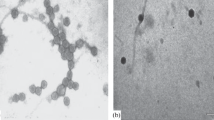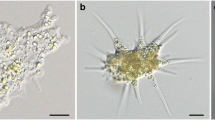Abstract
Culture studies with healthy and virus-infected isolates of Ectocarpus siliculosus, Feldmannia simplex and F. irregularis gave the following results:
-
Virus particles are produced in deformed reproductive organs (sporangia or gametangia) of the hosts and are released into the surrounding seawater.
-
Their infective potential is lost after several days of storage under laboratory conditions.
-
New infections occur when gametes or spores of the host get in contact with virus particles. The virus genome enters all cells of the developing new plant via mitosis.
-
Virus expression is variable, and in many cases the viability of the host is not impaired. Infected host plants may be partly fertile and pass the infection to their daughter plants.
-
Meiosis of the host can eliminate the virus genome and generate healthy progeny.
-
The genome of the Ectocarpus virus consists of dsDNA. Meiotic segregation patterns suggest an intimate association between virus genome and host chromosomes.
-
An extra-generic host range has been demonstrated for the Ectocarpus virus.
-
Field observations suggest that virus infections in ectocarpalean algae occur on all coasts of the world, and many or all Ectocarpus and Feldmannia populations are subject to contact with virus genomes.
Similar content being viewed by others
References
Lanka, S., M. Klein, U. Ramsperger, D. G. Müller & R. Knippers, 1993. Genome structure of a virus infecting the marine brown alga Ectocarpus siliculosus. Virology, in press.
Lüning, K. 1990. Seaweeds. Their Environment, Biogeography, and Ecophysiology. Wiley & Sons, NY, 527 pp.
Müller, D. G., 1991a. Mendelian segregation of a virus genome during host meiosis in the marine brown alga Ectocarpus siliculosus. J. Plant. Physiol 137: 739–743.
Müller, D. G., 1991b. Marine virioplankton produced by infected Ectocarpus siliculosus (Phaeophyceae). Mar. Ecol. Progr. Ser. 76: 101–102.
Müller, D. G., 1992. Intergeneric transmission of a marine plant DNA virus. Naturwissenschaften 79: 37–39.
Müller, D. G., H. Kawai, B. Stache & S. Lanka, 1990. A virus infection in the marine brown alga Ectocarpus siliculosus (Phaeophyceae). Bot. Acta 103: 72–82.
Müller, D. G. & B. Stache, 1992. Worldwide occurrence of virus-infections in filamentous marine brown algae. Helgoländer Meeresunters. 46: 1–8.
Reanney, D. C., 1974. Viruses and evolution. Int. Review Cytol. 37: 21–52.
Starr, R. C. & J. A. Zeikus, 1987. UTEX - The culture collection of algae at the University of Texas at Austin. J. Phycol. 23 Suppl.: 1–74.
Van Etten, J. L., L. C. Lane & R. H. Meints, 1991. Viruses and viruslike particles of eukaryotic algae. Microbiol. Rev.: 586–620.
Author information
Authors and Affiliations
Rights and permissions
About this article
Cite this article
Müller, D.G., Frenzer, K. Virus infections in three marine brown algae: Feldmannia irregularis, F. simplex, and Ectocarpus siliculosus . Hydrobiologia 260, 37–44 (1993). https://doi.org/10.1007/BF00049001
Issue Date:
DOI: https://doi.org/10.1007/BF00049001




